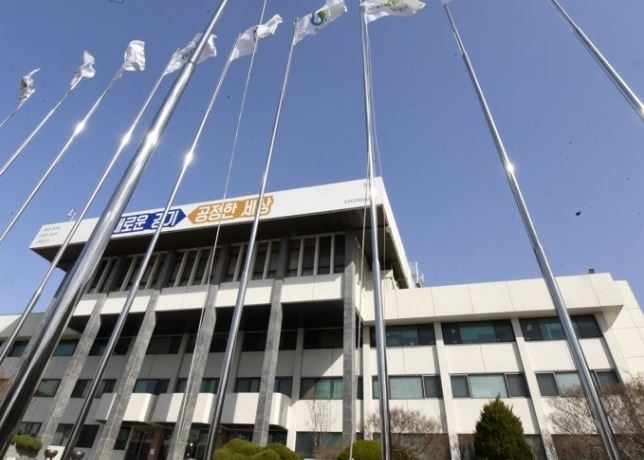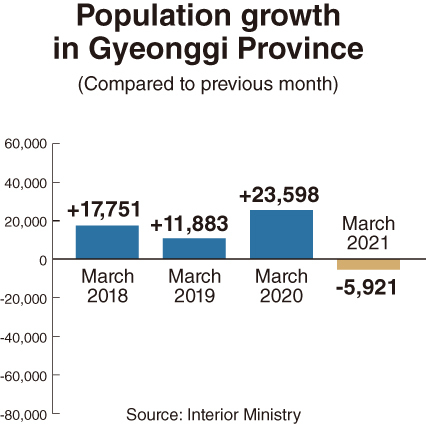 |
The headquarters of the Gyeonggi Provincial Office in Suwon (Yonhap) |
SEJONG -- Gyeonggi Province saw the number of its residents decline last month after posting continuous population growth since the early 1990s.
According to the Ministry of Interior and Safety, the population of Gyeonggi -- the most populous of South Korea’s 17 provinces and major cities -- fell by 5,921 (200 men and 5,721 women) in March to record 13.46 million people.
Its monthly decline is noteworthy, given that Gyeonggi -- alongside Sejong -- had maintained a steady increase in its demographic figures despite a nationwide population decline over the past year. (In metropolitan cities such as Seoul and Busan, the population decline started earlier.)
During the period from February 2011 through February 2021, the province’s population increased by 1.66 million, or 14 percent, from 11.81 million to 13.47 million.
The sharp increase was mainly attributed to the ongoing influx of Seoulites to Gyeonggi’s new residential towns, built in accordance with government housing supply policies.
 |
(Graphic by Han Chang-duck/The Korea Herald) |
The population of Gyeonggi Province dipped for a time in the 1980s after the city of Incheon broke away from the province in 1981, but had gradually rebounded since then.
Though the province is projected to expand further, at least for the next several years, in terms of its tally of residents, last month’s slide could suggest that the demographic trends apparent in the rest of the country -- for example, record-low fertility rates and falling marriage rates -- have also started affecting Gyeonggi.
But the deciding factor is most likely the COVID-19 pandemic, which caused a drastic decline in the numbers of newly registered foreign residents each month.
Nationwide in March, Korea’s population posted a monthly fall of 118,237 people -- the largest since the nation started compiling the data officially.
The nation’s population, which had declined to 51.705 million as of last month, was at its lowest in more than four years, since January 2017, when it stood at 51.704 million. The figures for the nation as a whole began a de facto downhill trajectory in December 2019.
Seoul saw the steepest on-month population decrease, losing 50,122 residents in March. Its population fell below the 9.6 million mark to 9.59 million.
Busan marked the second-biggest fall, losing 15,362 residents. This was followed by Gyeonggi Province, with 5,921 fewer residents; South Gyeongsang Province, with 5,582 fewer; Incheon, with 5,244 fewer; and South Jeolla Province, with 4,984 fewer.
Other regions that saw their populations decline were Gangwon Province, with 4,476 fewer residents; Daegu, with 4,316 fewer; North Jeolla Province, with 3,869 fewer; South Chungcheong Province, with 3,719 fewer; Ulsan, with 3,699 fewer; and Daejeon, with 3,601 fewer.
Of the eight major cities and nine provinces, only Sejong recorded positive growth, gaining 893 residents and breaking the 360,000 (360,462) mark for the first time in history. The administrative city, where the nation’s largest government complex is located, was established in July 2012 and is still expanding.
Deaths outnumbered births nationwide last month by 28,626 vs. 24,810 -- a reversal of the situation in past decades.
While the nationwide gap between deaths and births stood at 3,916, other factors pushed the population decrease to 118,237 people.
These included citizenship changes -- Koreans renouncing their citizenship and foreigners acquiring Korean citizenship -- and changes to the long-term residency status of Koreans overseas and foreign nationals here.
By Kim Yon-se (
kys@heraldcorp.com)






![[Exclusive] Hyundai Mobis eyes closer ties with BYD](http://res.heraldm.com/phpwas/restmb_idxmake.php?idx=644&simg=/content/image/2024/11/25/20241125050044_0.jpg)
![[Herald Review] 'Gangnam B-Side' combines social realism with masterful suspense, performance](http://res.heraldm.com/phpwas/restmb_idxmake.php?idx=644&simg=/content/image/2024/11/25/20241125050072_0.jpg)

